In Toni Morrison’s novel Song of Solomon (1977), a young woman dies in the pursuit of ideal beauty. After spending her family’s life savings on make-up, hair products, hosiery and a new white dress, she catches a fever before burning out in the arms of her mother and grandmother, extinguished by the grief of not looking like the image of perfection instilled in her mind. While patriarchal society views hair styling, cosmetics and fashion as feminine frivolities that have only a peripheral bearing on human life, Morrison understands the gravity of these concerns. In an unequal world, striving to embody an established conception of beauty holds the promise of being taken more seriously, being loved and being seen: vital prospects if society views you as insignificant, ugly and unlovable. Morrison’s oeuvre is full of female characters for whom this kind of self-objectification offers a valuable (if not fatal) form of agency.
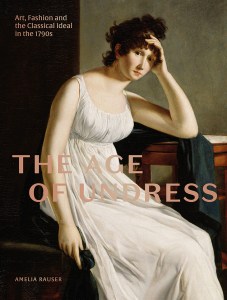 In The Age of Undress: Art, Fashion and the Classical Ideal in the 1790s, Amelia Rauser looks at the agency promised by ideal beauty in a distinct historical context: London, Paris, and other European centres during the final decade of the 18th century. Rauser explores how – through clothing, hair, toilette and overall styling – many women in this particular milieu presented themselves as living Greco-Roman statues, figures seen during the period as embodiments of the human form at its most beautiful. The author argues that this was a highly significant phenomenon, a kind of artistic practice that allowed women to wade into the aesthetic, intellectual and, to a lesser extent, political discourses that characterise this revolutionary and war-torn time. She terms this transdisciplinary practice ‘neoclassical dress’.
In The Age of Undress: Art, Fashion and the Classical Ideal in the 1790s, Amelia Rauser looks at the agency promised by ideal beauty in a distinct historical context: London, Paris, and other European centres during the final decade of the 18th century. Rauser explores how – through clothing, hair, toilette and overall styling – many women in this particular milieu presented themselves as living Greco-Roman statues, figures seen during the period as embodiments of the human form at its most beautiful. The author argues that this was a highly significant phenomenon, a kind of artistic practice that allowed women to wade into the aesthetic, intellectual and, to a lesser extent, political discourses that characterise this revolutionary and war-torn time. She terms this transdisciplinary practice ‘neoclassical dress’.
Neoclassical dress was more than a craze for ‘Grecian’ gowns and accessories. Eschewing the rouge, corsetry and powdered wigs that had long been in style, these women set out to appropriate ancient marbles, turning their bodies into texts that, as Rauser explores, conveyed the primacy of sensuality and emotion in the appreciation of the classical past, and in art and life more broadly. Across five concise chapters, each framed by a preface explaining a central concept (‘Drape’, ‘Transparency’, ‘High-Waistedness’, ‘Whiteness’, ‘Lightness’), Rauser posits neoclassical dress as the repressed heart and soul of an era that is all too often characterised by an inherently masculine regard for restraint, order and rationality.
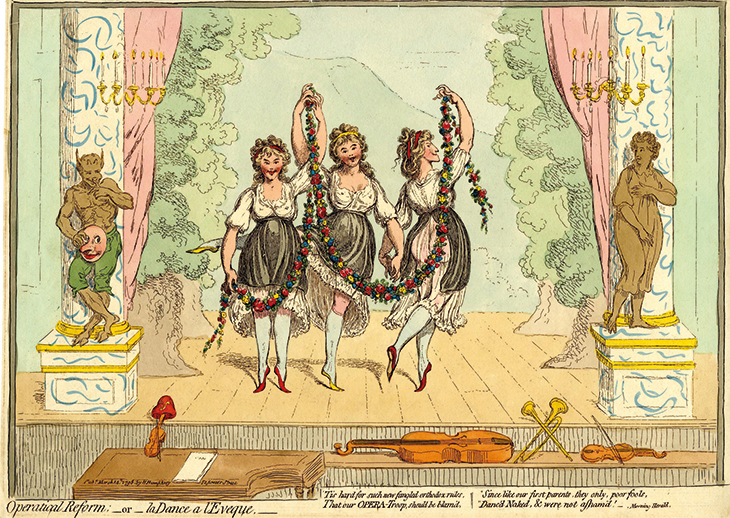
Operatical Reform; – or – la Dance à l’Eveque (1798), James Gillray. British Museum, London
Rauser seems cautious about lending much weight to the political ramifications of neoclassical dress. For her this was fundamentally an ‘aesthetic project’. Yet the notion of freedom lies at the heart of the book. On one hand there is the corporeal freedom that was brought about by the abandonment of whalebone bodices and layered petticoats in favour of the thin, simple, white muslin approximations of classical drapery that, by the end of the 1790s, were ubiquitous in London and Paris. On the other hand, there is the more elusive notion of ‘subjective freedom’; neoclassical dress signalled the desire for the internal, metaphysical kind of freedom because of the long-standing connection between Greco-Roman sculpture and classical republican values of ‘virtue, liberty, and embodied integrity’. While male radicals and revolutionaries took these values to the streets, putting them to use as the basis of a new world order, the women discussed by Rauser used neoclassical dress to stake their own claim to free and autonomous humanity.
Radical politics and the vogue for antiquity were conflated both during that period and in subsequent historiography. A print of 1798 by the satirist James Gillray, for example, shows three female dancers clad in neoclassical dress sharing the stage with a tiny red Phrygian cap, the scene a synecdoche of the French Revolution. Rauser indicates, however, that these were wholly separate movements. The bodily and subjective freedoms promised by neoclassical dress transcended political allegiances. After her death Marie Antoinette, the very personification of the ancien régime, could be depicted by the painter William Hamilton in a high-waisted Grecian-style white gown. The multivalent freedom of neoclassical dress is encapsulated by one of its chief proponents, the Paris-based socialite Thérésa Tallien. Born in Spain to an enterprising financier, Tallien married into the French elite but reinvented herself in 1791, taking up with a prominent revolutionary activist. Marked out by her aristocratic connections, she soon found herself imprisoned by Robespierre. Her famous charms clearly played a role in her narrow escape from the guillotine and early release. For Tallien beauty was, quite literally, freedom.
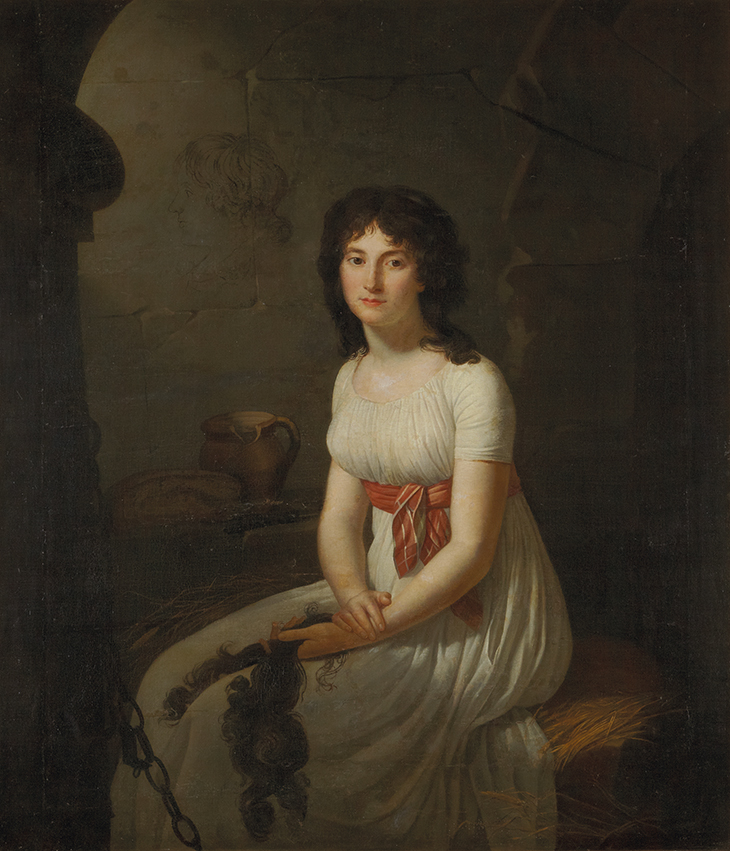
Comrade Tallien in a Cell, Holding Her Cut Hair (1796), Jean-Louis Laneuville. Private collection. Photo: courtesy Yale University Press; © Christies Images/Bridgeman Images
Despite its distance from radical politics, it would be tempting to see neoclassical dress as a feminist gesture. But the passage in A Vindication of the Rights of Woman, first published in 1792, in which Mary Wollstonecraft urges women to adopt the beauty of ‘the Grecian statues’ to rid themselves of oppression, is not useful for Rauser’s purposes. Perhaps this is because neoclassical dress did little for the nascent feminism nurtured by Wollstonecraft during the period; ‘by the 1820s,’ Rauser points out, ‘corsets, ornaments, silks and full skirts’ – the restrictive garments of yesteryear – were firmly ‘back in fashion’. There is also the fact that, as the book eloquently explores, the freedom of neoclassical dress was contingent on the suffering of women, and men, in other parts of the world. Not only was the raw cotton used to make muslin gowns increasingly reliant on African slave labour; Rauser examines how, perhaps unexpectedly given its orientation towards a purified fantasy of ancient Greece, neoclassical dress combined the ideal of the living marble statue with elements sourced from Creole style such as gold hoop earrings and head-wraps (both of which became fashionable after they were worn by Tallien). Contrasting with the plain Grecian dresses, signifiers of what might be called ‘plantation chic’ reinforced the whiteness, and the comparative freedom, of the European women experimenting with the look, as seen in François Beaucourt’s Portrait of a Haitian Woman (1786). If one did identify neoclassical dress as an early feminist gesture, the trend’s complicity in the oppression of colonised and enslaved people would provide a compelling precursor to the troubled relationship between feminism and anti-racist activism that comes into view a century later.
The Age of Undress grants fashion and beauty the significance they possessed, and continue to possess, in countless women’s lives. The question of emancipation remains unresolved, but perhaps this is the point. Fashion and beauty are neither frivolities nor do they offer a viable way of bringing about social justice. Yet they should certainly not, as Rauser’s book affirms, be judged purely as indices of male domination. In an unequal world, they are tools we can use to sculpt ourselves.
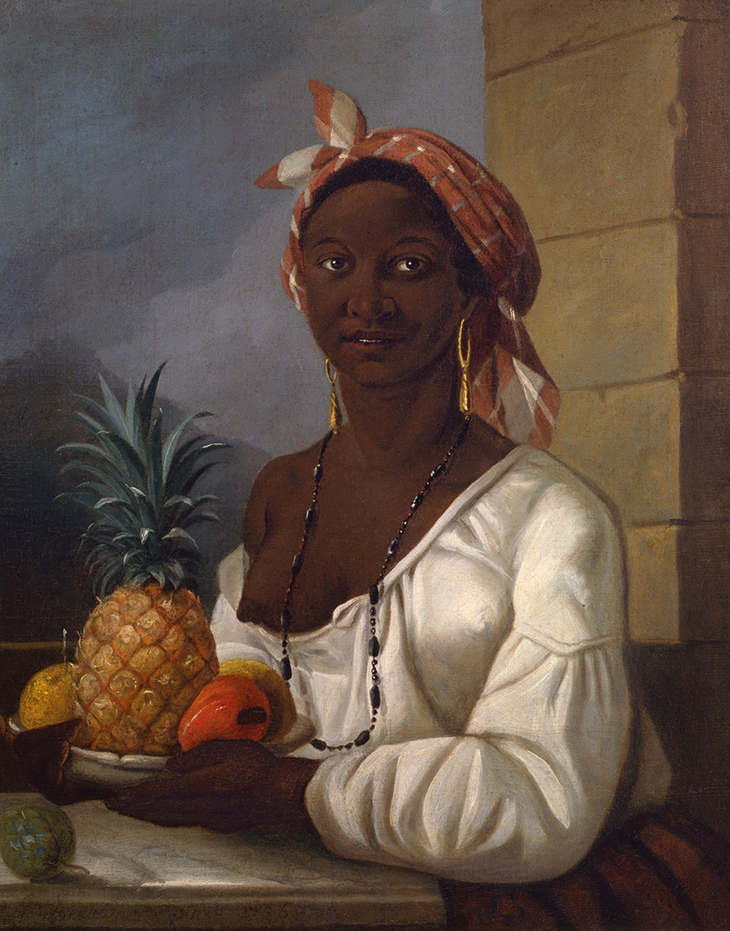
Portrait of a Haitian Woman (1786), François Malépart de Beaucourt. McCord Museum, Montreal
The Age of Undress: Art, Fashion and the Classical Ideal in the 1790s by Amelia Rauser is published by Yale University Press.
From the September 2020 issue of Apollo. Preview and subscribe here.
Unlimited access from just $16 every 3 months
Subscribe to get unlimited and exclusive access to the top art stories, interviews and exhibition reviews.

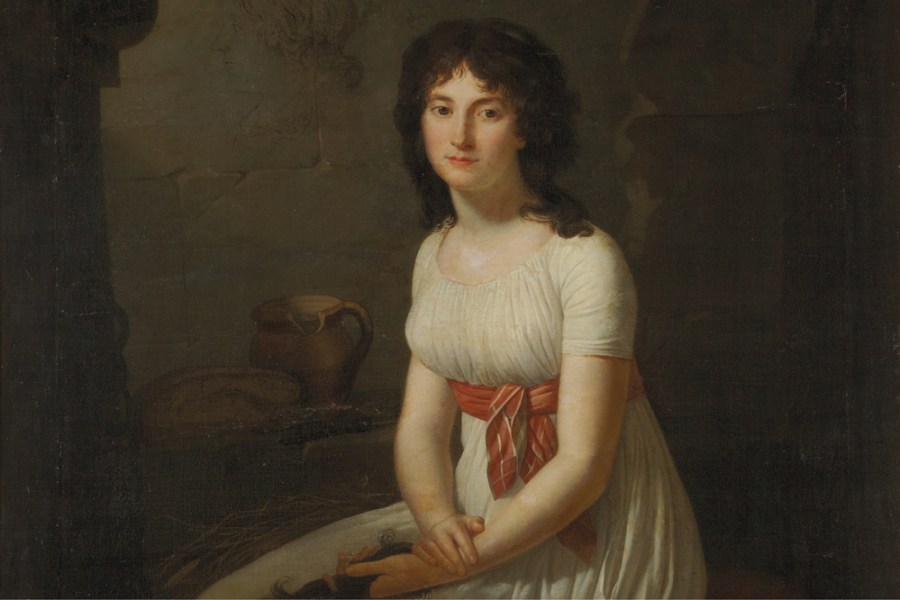
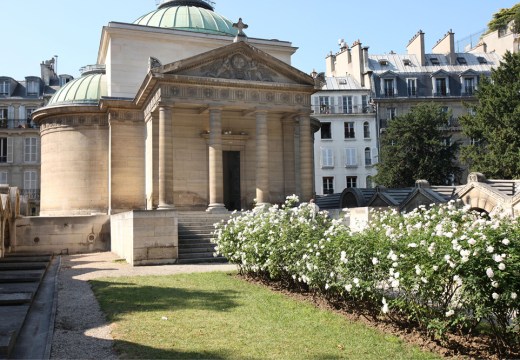
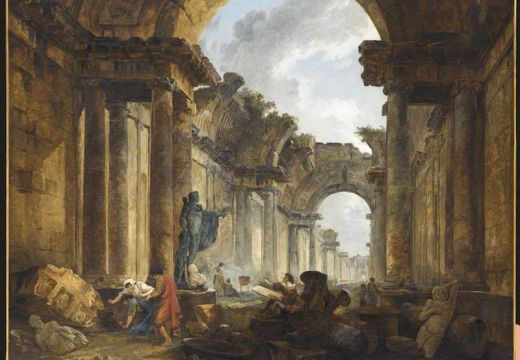
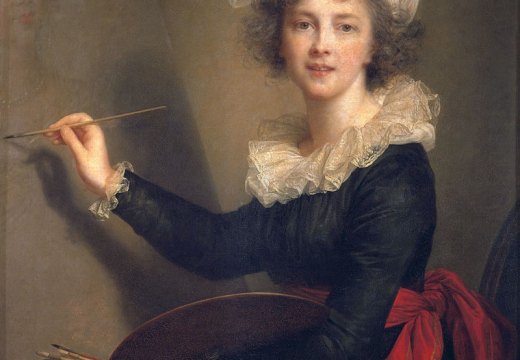









![Masterpiece [Re]discovery 2022. Photo: Ben Fisher Photography, courtesy of Masterpiece London](http://www.apollo-magazine.com/wp-content/uploads/2022/07/MPL2022_4263.jpg)
It’s time for the government of London to return to its rightful home